Related Research Articles

Rail transport in New Zealand is an integral part of New Zealand's transport network, with a nationwide network of 4,375.5 km (2,718.8 mi) of track linking most major cities in the North and South Islands, connected by inter-island rail and road ferries. Rail transport in New Zealand has a particular focus on bulk freight exports and imports, with 19 million net tonnes moved by rail annually, and 99.5% of New Zealand's exports and imports being transported through the country's seaports.

The Main North Line between Picton and Christchurch and the Main South Line between Lyttelton and Invercargill, running down the east coast of the South Island of New Zealand, are sometimes together referred to collectively as the South Island Main Trunk Railway (SIMT). Construction of a line running the length of the east coast began in the 1860s and was completed all the way from Picton to Invercargill in 1945; the last sections being on the Main North Line south of Picton. The designation "South Island Main Trunk" originally referred to only that line between Christchurch and Invercargill.
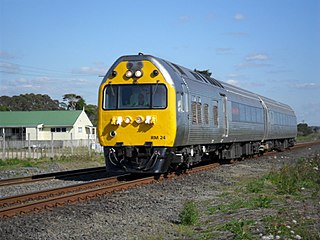
The NZR RM class Silver Fern was a class of rail motor in New Zealand. The three air-conditioned and sound-proofed 723-kW 96-seater diesel-electric twin-set railcars were built by Kawasaki under contract with Nissho Iwai of Japan. New Zealand Railways (NZR) classified the railcars as RM (Rail Motor), the same as other railcars, using the Silver Ferns (a national symbol of New Zealand) because of their exterior was made of corrugated stainless steel, like the premier night sleeper train that also ran on the Wellington-Auckland (North Island Main Trunk) route, the Silver Star. The Silver Ferns replaced the three successful Blue Streak railcars on the service.
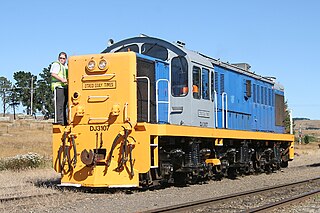
The New Zealand DJ class locomotive is a type of diesel-electric locomotive in service on the New Zealand rail network. The class were built by Mitsubishi Heavy Industries and introduced from 1968 to 1969 for the New Zealand Railways Department (NZR) with a modernisation loan from the World Bank to replace steam locomotives in the South Island, where all of the class members worked most of their lives. Nine of the locomotives remain in use, mainly with Dunedin Railways.
The Southerner was a passenger express train in New Zealand's South Island between Christchurch and Invercargill along the South Island Main Trunk, that ran from 1970 to 2002. It was one of the premier passenger trains in New Zealand and its existence made Invercargill the southernmost passenger station in the world.
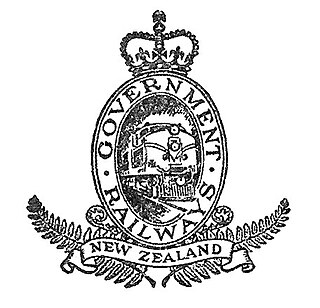
The New Zealand Railways Department, NZR or NZGR and often known as the "Railways", was a government department charged with owning and maintaining New Zealand's railway infrastructure and operating the railway system. The Department was created in 1880 and was corporatised on 1 April 1982 into the New Zealand Railways Corporation. Originally, railway construction and operation took place under the auspices of the former provincial governments and some private railways, before all of the provincial operations came under the central Public Works Department. The role of operating the rail network was subsequently separated from that of the network's construction. From 1895 to 1993 there was a responsible Minister, the Minister of Railways. He was often also the Minister of Public Works.
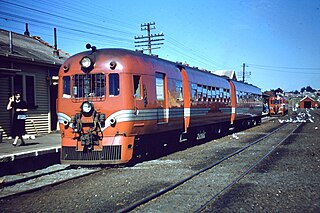
The NZR RM class 88-seaters were a class of railcar used in New Zealand. New Zealand Government Railways (NZR) classified them as RM (Rail Motor), the notation used for all railcars, numbering the 35 sets from RM100 to RM134. They were the most numerous railcars in NZR service. Their purchase and introduction saw the demise of steam-hauled provincial passenger trains and mixed trains, and was part of a deliberate effort to modernise NZR passenger services at a time of increasing competition from private motor vehicles. Being diesel powered and lighter the railcars were less expensive to operate and able to maintain quicker timetables, although became plagued with mechanical and electrical problems, with a number of the class eventually being turned into depowered locomotive-hauled carriages and reclassified as the AC class "Grassgrubs".
The Endeavour was a long-distance passenger train service between Wellington and Napier in the North Island of New Zealand. The service was modelled on the Southerner service in the South Island, and operated from 1972 to 1989.
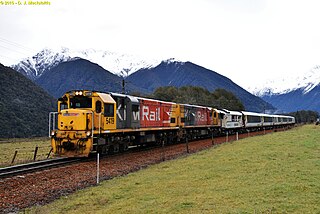
The TranzAlpine is a passenger train operated by the Great Journeys New Zealand division of KiwiRail in the South Island of New Zealand over the Midland Line; often regarded to be one of the world's great train journeys for the scenery through which it passes. The journey is 223 kilometres (139 mi) one-way, taking almost five hours. There are 16 tunnels and four viaducts, with the Staircase Viaduct elevated as much as 75 metres (246 ft).
This is a list of jargon commonly used by railfans and railway employees in New Zealand.
The Bay Express was a passenger train between Wellington and Napier in New Zealand's North Island, operating from Monday, 11 December 1989 until Sunday, 7 October 2001. It was operated by New Zealand Railways Corporation's InterCity Rail division, later known as Tranz Scenic.

The Coastal Pacific is a long-distance passenger train that runs between Picton and Christchurch in the South Island of New Zealand. It is operated by the Great Journeys New Zealand division of KiwiRail. It was called the TranzCoastal from May 2000 until temporarily withdrawn in February 2011. It was the first train to use the new AK class carriages.

The Main North Line, sometimes referred to as part of the South Island Main Trunk railway, is a railway line that runs north from Christchurch in New Zealand up the east coast of the South Island through Kaikōura and Blenheim to Picton. It is a major link in New Zealand's national rail network and offers a connection with roll-on roll-off ferries from Picton to Wellington. It was also the longest railway construction project in New Zealand's history, with the first stages built in the 1870s and not completed until 1945.
The Kaimai Express long-distance passenger train was operated by Tranz Rail under the Tranz Scenic brand between the North Island cities of Auckland and Tauranga via Hamilton. It used the Silver Fern railcars and operated from 9 December 1991 until 7 October 2001.

The RM class was the classification used by the New Zealand Railways Department (NZR) and its successors gave to most railcars and railbuses that have operated on New Zealand's national rail network. "RM" stands for Rail Motor which was the common name at the turn of the 20th century for what became known in New Zealand as railcars. As many types of railcars are operated, class names have been given to each railcar type to differentiate them from others.
The Culverden Express was a passenger train operated by the New Zealand Railways Department between Christchurch and Culverden. It ran from 1886 until its replacement by the Picton Express in 1945 and its route followed both the Main North Line and the Waiau Branch. In the mid-1920s, the main northern terminus became Parnassus, and to reflect this, the name was changed to the Parnassus Express.

The New Plymouth Express was a passenger express train operated by the New Zealand Railways Department (NZR) between Wellington and New Plymouth. It ran from 1886 until 1955 and was sometimes known as the New Plymouth Mail due to the Railway Travelling Post Office carriages included in its consist. The Express was notable amongst NZR's provincial expresses as being both the first and, until the commencement of the Gisborne Express in 1942, the longest in distance travelled.
The New Plymouth Night Express was a passenger express train operated by the New Zealand Railways Department (NZR) that ran between Auckland and New Plymouth. It ran in various forms from 1933 until 1983, though the Express designation was lost in 1956 and later incarnations did not operate at night and terminated in Taumarunui rather than Auckland. The New Plymouth Night Express should not be confused with the New Plymouth Express that operated between New Plymouth and Wellington.
The Wairarapa Mail was a passenger train operated by the New Zealand Railways Department (NZR) between Wellington and Woodville, continuing on to Palmerston North as a mixed train. It ran from 1909 until 1948 and its route included the famous and arduous Rimutaka Incline.

The NZR 56-foot carriage is a class of 56 ft (17 m) long railway passenger carriage formerly used on almost all long-distance passenger rail transport in New Zealand. 88 carriages have been preserved.
References
Citations
- 1 2 3 4 Mahoney 1982, p. 105.
- 1 2 "The New Christchurch-Picton Train Service". New Zealand Railway Observer. New Zealand Railway and Locomotive Society. 33 (147): 127. Spring 1976. ISSN 0028-8624.
- 1 2 "Tranz-Alpine Express Popular". New Zealand Railway Observer. New Zealand Railway and Locomotive Society. 45 (194): 75. Winter 1988. ISSN 0028-8624.
- 1 2 Churchman & Hurst 2001, p. 177.
- ↑ Mahoney 1982, p. 106.
- ↑ Mahoney 1982, p. 111.
- ↑ "New Picton Line Train". Rails . Southern Press Ltd: 15. August 1976. ISSN 0110-6155.
- 1 2 "Picton Express Re-Equipped". New Zealand Railway Observer. New Zealand Railway and Locomotive Society. 39 (172): 153. Summer 1982–83. ISSN 0028-8624.
- ↑ Churchman & Hurst 2001, p. 64.
Bibliography
- Churchman, Geoffrey B; Hurst, Tony (2001) [1990, 1991]. The Railways of New Zealand: A Journey through History (Second ed.). Transpress New Zealand. ISBN 0-908876-20-3.
- Mahoney, J. D. (1982). Kings of the Iron Road. Palmerston North: Dunmore Press. ISBN 978-0864692184.